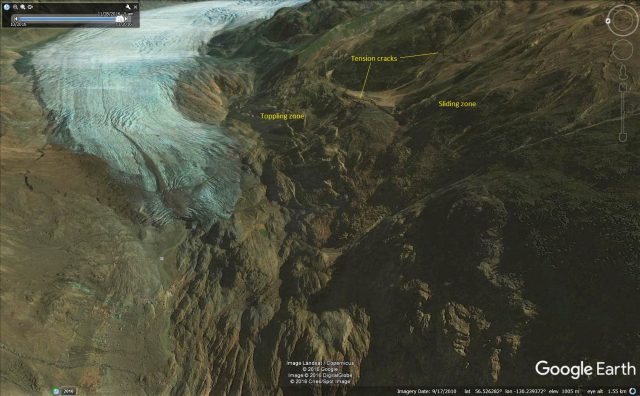24 March 2017
The Mitchell Creek landslide in British Columbia, Canada
Posted by Dave Petley
The Mitchell Creek landslide in British Columbia, Canada
The Mitchell Creek landslide is a very large, complex failure that has developed in response to the retreat of the Mitchell Valley Glacier in British Columbia, Canada. In a paper just published in the journal Landslides, Clayton et al. (2017) describe how this very complex and large (more than 1 km wide and 1 km long) landslide started to develop sometime between 1956 and 1972 as the slope was debuttressed due to the loss of ice at the toe. Since then parts of the landslide have moved by 40 metres or more.
The Google Earth image below, collected in 2010, shows the landslide. The location is 56.525, -130.233 if you want to take a look. Note I have had to change the contrast in the image to make it easier to see. The Mitchell Glacier is at the toe of the slide, whilst tension cracks are clearly evident on the slope behind.:-

Google Earth image of the Mitchell Creek landslide in BC
.
In many ways though this landslide is easier to understand from the side, as this Google Earth image shows:

Google Earth image of the Mitchell Creek landslide, annotated with the major zones identified by Clayton et al. (2017)
.
The key to this landslide has been the retreat of the Mitchell Glacier, which can be seen in the image above. As the ice has melted the slope has been debuttressed – a well-known mechanism – and has started to deform. Clayton et al. (2017) have identified three major zones in the landslide – at the rear a sliding zone (in the images above the huge tension cracks are clearly visible), which is moving at about 20 cm per year on average. At the front there is a zone of toppling, which is moving much faster – about 80 cm per year. Between the two is a transition zone, in which movement rates are about 33 cm per year and in which the blocks are showing evidence of subsidence. Clayton et al. (2017) have used this to generate a really nice conceptual model of the landslide, below, which demonstrates in a very straightforward way the manner in which this landslide is developing:

Simple conceptual model of the Mitchell Creek landslide, from Clayton et al. (2017)
.
If you compare this model with the Google Earth images above then the behaviour of the landslide becomes clear. It will be fascinating to see how this behaves in the next few years.
Reference
Clayton, A., Stead, D., Kinakin, D. et al. 2017. Engineering geomorphological interpretation of the Mitchell Creek Landslide, British Columbia, Canada. Landslides doi:10.1007/s10346-017-0811-1


 Dave Petley is the Vice-Chancellor of the University of Hull in the United Kingdom. His blog provides commentary and analysis of landslide events occurring worldwide, including the landslides themselves, latest research, and conferences and meetings.
Dave Petley is the Vice-Chancellor of the University of Hull in the United Kingdom. His blog provides commentary and analysis of landslide events occurring worldwide, including the landslides themselves, latest research, and conferences and meetings.
It’s worth noting that this is directly downslope of the Seabridge Gold exploration camp for the soon to be developed KSM mine. If it goes ahead, it will be a very large mine that will face some very interesting challenges from a geohazard perspective.